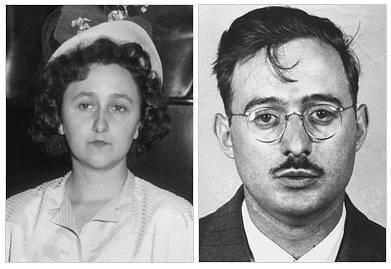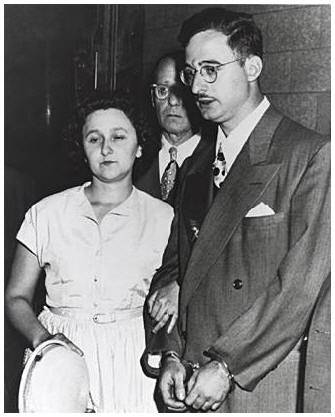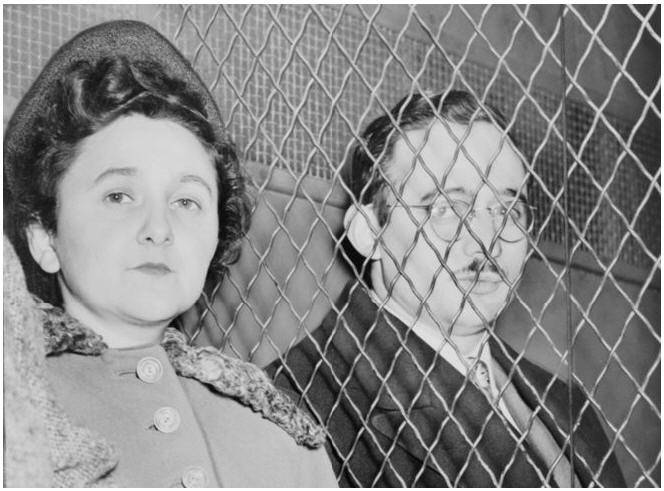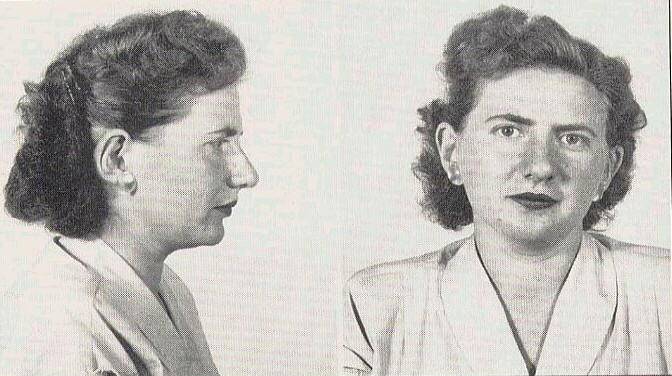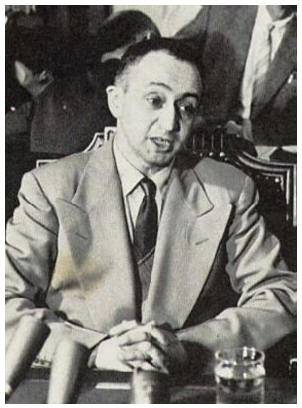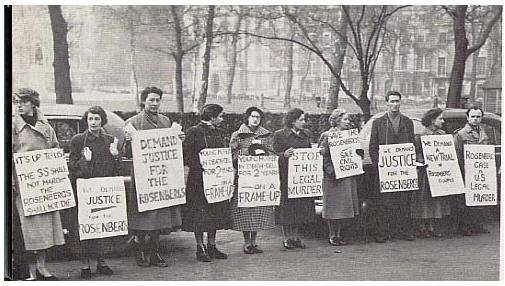|

|
Julius and Ethel Rosenberg
Julius Rosenberg and Ethel Greenglass
Rosenberg were American communists who were executed after having been
found guilty of conspiracy to commit espionage. The charges were in
relation to the passing of information about the American atomic bomb
to the Soviet Union. Theirs was the first execution of civilians for
espionage in United States history.
The guilt of the Rosenbergs and the appropriateness of their sentence have
been the subject of perennial debate. Information released after the Cold
War confirmed that he acted as a courier and recruiter for the Soviets.
Other atomic spies providing information to the Soviets were arrested but
not executed. Ethel's brother, David
Greenglass, who supplied the documents
to Julius, served 15 years. Harry Gold served 15 years in Federal prison
as the courier for Klaus Fuchs. Morton
Sobell, who was tried with the
Rosenbergs,
served 17 years and 9 months.
|
| |
|
Background
Julius Rosenberg was born to a family of Jewish immigrants in New York City
on May 12, 1918. His parents worked in the sweat shops of the Lower East
Side. Julius became a leader in the Young Communist League where, in 1936,
he met Ethel, whom he married three years later. He graduated from the City
College of New York with a degree in electrical engineering in 1939 and
joined the Army Signal Corps in 1940, where he worked on radar equipment.
Ethel Greenglass was born on September 28, 1915, in New York City, also to a
Jewish family. She was an aspiring actress and singer, but eventually took a
secretarial job at a shipping company. She became involved in labor disputes
and joined the Young Communist League, USA, where she met Julius. The
Rosenbergs had two sons named Robert and Michael, who were adopted by
teacher and songwriter Abel Meeropol (and took the
Meeropol surname) after
their parents' execution.
According to his former NKVD handler,
Alexandre
Feklisov, Julius Rosenberg
was originally recruited by the KGB on Labor Day 1942, by former
NKVD
spymaster Semyon
Semenov. Julius had been introduced to
Semenov by
Bernard Schuster, a high-ranking member of the Communist Party USA as well
as Earl Browder's personal
NKVD liaison, and after
Semenov was recalled to
Moscow in 1944, his duties were taken over by his apprentice,
Feklisov.
Rosenberg Gave The Soviet
Jews A Proximity Fuse
According to Feklisov,
Julius provided thousands of classified reports from Emerson Radio,
including a complete proximity fuze,
the same design that was used to shoot down Gary Powers's
U-2 in 1960. Under Feklisov's
administration, Julius Rosenberg is said to have recruited sympathetic
individuals to the KGB’s service, including Joel Barr, Alfred Sarant,
William Perl and Morton
Sobell.[8]
According to Feklisov's account, he was supplied by Perl, under Julius
Rosenberg’s direction, with thousands of documents from the National
Advisory Committee for Aeronautics including a complete set of design and
production drawings for the Lockheed's P-80 Shooting Star.
Feklisov says he
learned through Julius that his brother-in-law David Greenglass
was working on the top-secret Manhattan Project at the Los Alamos National
Laboratory and used Julius to recruit him.
The US Government Is
Shocked At Russian Atom Bomb Technology
After the war, the U.S. continued to protect its nuclear secrets, but the
Soviet Union was able to produce its own atomic weapons by 1949. The West was shocked by the speed
with which the Soviets were able to stage their first nuclear test, "Joe 1."
It was then discovered in January 1950 that a German refugee theoretical
physicist working for the British mission in the Manhattan Project, Klaus
Fuchs, had given key documents to the Russians throughout the war.
Through Fuchs' confession, U.S. and United Kingdom intelligence agents were
able to make a case against his alleged courier, Harry Gold, who was
arrested on May 23, 1950. A former machinist at Los Alamos, Sergeant David
Greenglass confessed to having passed secret information on to the USSR
through Gold as well. Though he initially denied any involvement by his
sister, Ethel Rosenberg, he claimed that her husband, Julius, had convinced
his wife to recruit him while on a visit to him in Albuquerque, New Mexico
in 1944 and that Julius had also passed secrets. Another conspirator, Morton
Sobell, was on vacation in Mexico City when both
Rosenbergs were arrested.
According to his story published in On Doing Time, he tried to figure out a
way to reach Europe without a passport but ultimately abandoned that effort
and was back in Mexico City when he was kidnapped by members of the Mexican
secret police and driven to the U.S. border where he was arrested. The
government claimed he had been deported, but in 1956 the Mexican government
officially declared that he had never been deported. Regardless of how he
was returned to the U.S., he was arrested and stood trial with the
Rosenbergs on one count of conspiracy to commit espionage.
Trial and conviction
The trial of the Rosenbergs and
Sobell began on
March 6, 1951. The judge was Irving Kaufman. The attorney for the
Rosenbergs
was Emanuel Hirsch Bloch.[10] The prosecution's primary witness, David
Greenglass, stated that his sister Ethel typed notes containing U.S. nuclear
secrets in the Rosenberg apartment in September 1945. He also asserted that
a sketch he made of a cross-section of the implosion-type atom bomb (the one
dropped on Nagasaki, Japan, as opposed to the "gun method" triggering device
that was in the one dropped on Hiroshima) was also turned over to Julius
Rosenberg at that meeting.
From the beginning, the trial attracted a high amount of media attention,
like the trial of Alger Hiss. Aside from the
Rosenbergs'
own defense during the trial, there was not one single public expression
of doubt as to their guilt in any media (even the left-wing and Communist
press) before and during the trial.
Hollywood
Trash Back The Rosenbergs
However, between the trial and the
executions there were widespread protests and claims of anti-Semitism. Jean-Paul Sartre called the case "a legal lynching which smears with
blood a whole nation. By killing the
Rosenbergs, you have quite simply tried
to halt the progress of science by human sacrifice. Magic, witch-hunts,
auto-da-fés, sacrifices — we are here getting to the point: your country is
sick with fear... you are afraid of the shadow of your own bomb."[11]
Others, including non-Communists such as Albert Einstein (at that time, a
socialist) and Nobel-Prize-winning atomic scientist and chemist Harold
Urey,[citation needed] as well as Communists or left-leaning artists such as
Nelson Algren,
Dashiell Hammett, Jean Cocteau, Diego Rivera and
Frida
Kahlo,
protested the position of the American government in what some termed America's Dreyfus Affair.
Pablo Picasso wrote for a French magazine, "The hours count. The minutes
count. Do not let this crime against humanity take place."[12] Pope Pius XII
also condemned the execution.[13] The all-black International Longshoremen’s
Association Local 968 stopped working for a day in protest.[14] Cinema
artists such as Fritz Lang and
Bertolt
Brecht registered their protest.[15]
|
 |
| |
|
|
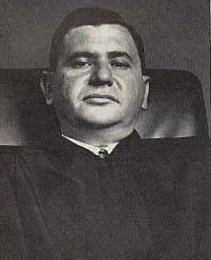
|
Jewish Judges Appointed
To Prosecute The Rosenbergs
It is thought that because the U.S. government feared
Communist propaganda about anti-semitism, events were manipulated so that
both the judge and prosecutor in the case were Jewish. This, however, didn't stop
celebrities and communists from making claims of anti-semitism.
Although the notes typed by Ethel apparently contained little that was
relevant to the Soviet atomic bomb project, this was sufficient evidence for
the jury to convict on the conspiracy to commit espionage charge.
|
| |
|
It is believed that part of the reason Ethel was indicted along with Julius
was so that the prosecution could use her as a 'lever' to pressure Julius
into giving up the names of others who were involved.[16] If that was the
case, it did not work. On the witness stand, Julius asserted his right under
the U.S. Constitution's Fifth Amendment to not incriminate himself whenever
asked about his involvement in the Communist Party or with its members.
Ethel did similarly. Neither defendant was viewed sympathetically by the
jury.
Jews Wanted The Death
Penalty So Rosenberg Wouldn't Talk
The role played by Assistant U.S. Attorney Roy Cohn, the prosecutor in the
case, is controversial. Cohn stated in his autobiography that he influenced
the selection of the judge, and pushed him to impose the death penalty on
both Ethel and Julius Rosenberg.
The Rosenbergs
were convicted on March 29, 1951, and on April 5 were sentenced to death by
Judge Irving Kaufman under Section 2 of the Espionage Act of 1917, 50 U.S.
Code 32 (now 18 U.S. Code 794), which prohibits transmitting or attempting
to transmit to a foreign government information "relating to the national
defense." 'The conviction helped to fuel Senator Joseph McCarthy's
investigations into anti-American activities by U.S. citizens. While their
devotion to the Communist cause was well-documented, the
Rosenbergs denied
the espionage charges even as they faced the electric chair.
The couple were the only two American civilians to be executed for
espionage-related activity during the Cold War.[18] In imposing the death
penalty, Kaufman noted that he held them responsible not only for espionage
but also for the deaths of the Korean War:
Execution
The couple were executed at sundown
in the electric chair at Sing Sing Correctional Facility in Ossining, New
York, on June 19, 1953.[1][22] This was delayed from the originally
scheduled date of June 18 because, on June 17, Supreme Court Associate
Justice William O. Douglas had granted a stay of execution. That stay
resulted from the intervention in the case of
Fyke Farmer, a Tennessee
lawyer whose efforts had previously met with scorn from the
Rosenbergs'
attorney.[23]
source
|
